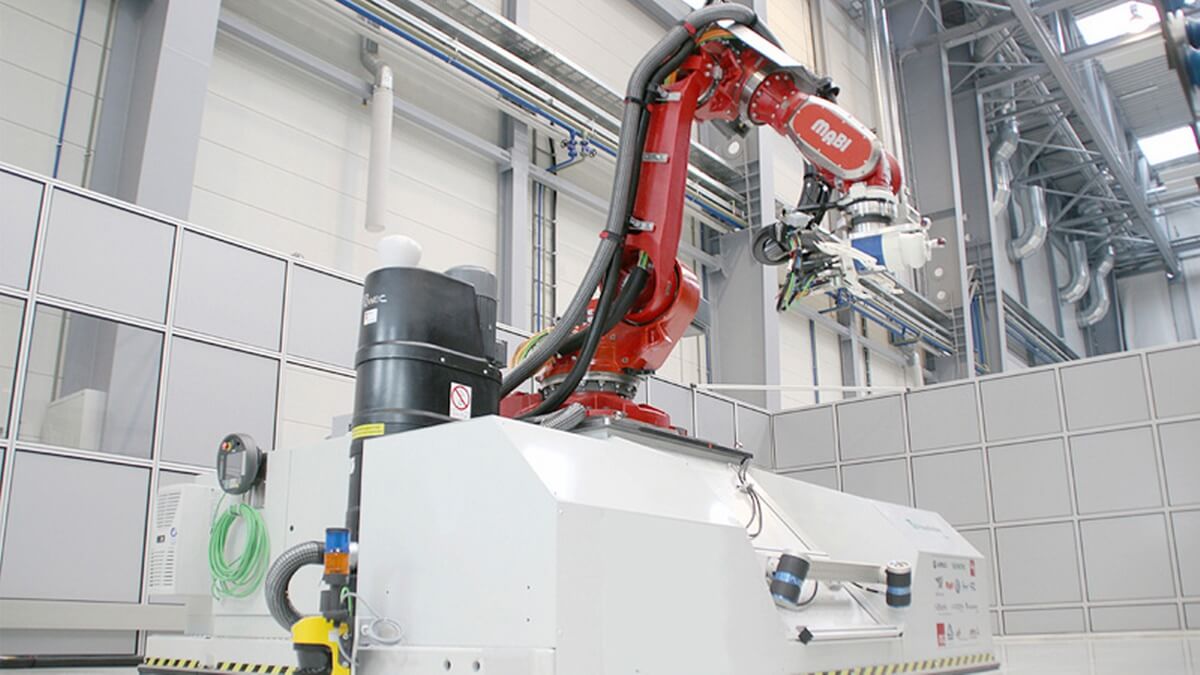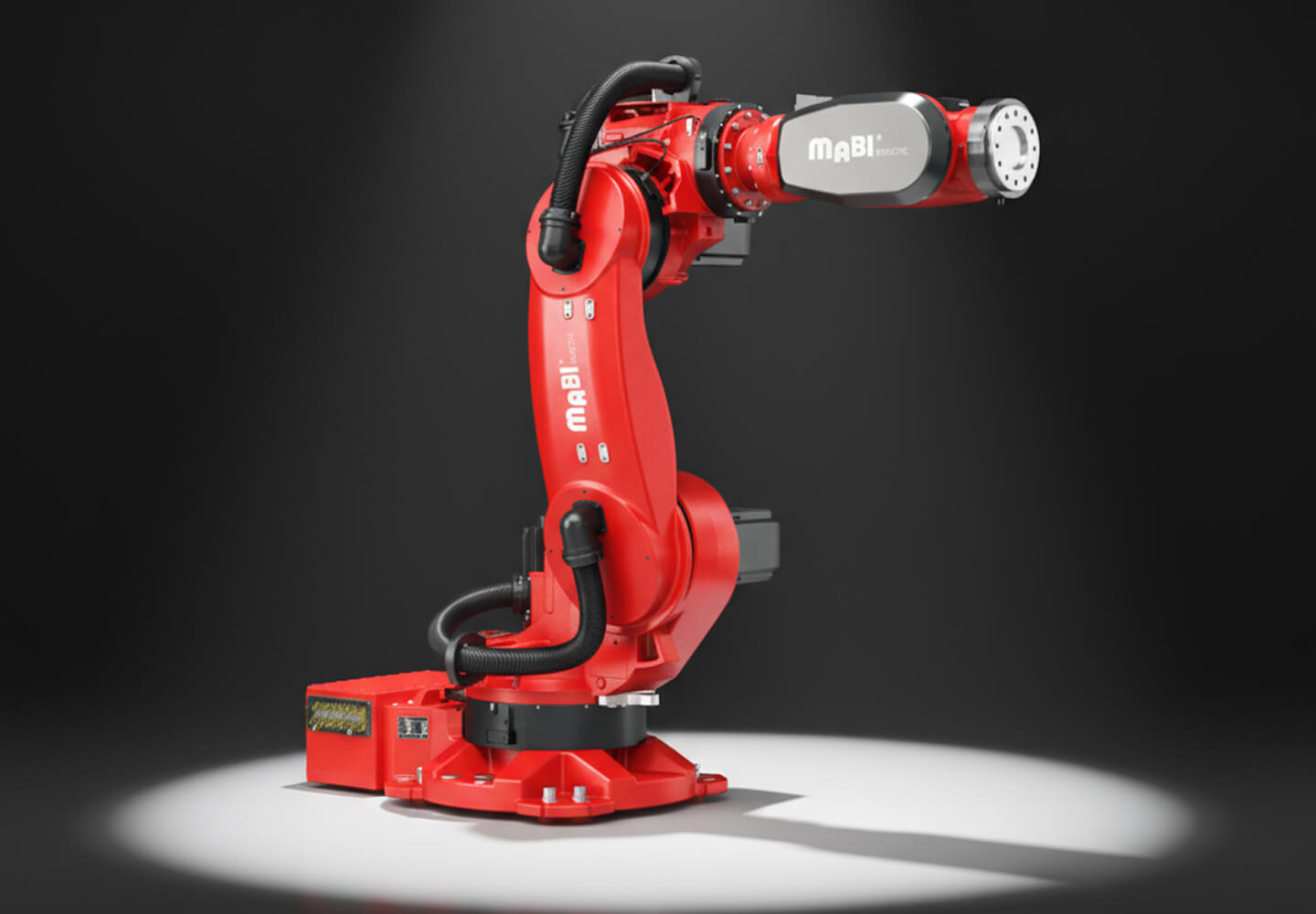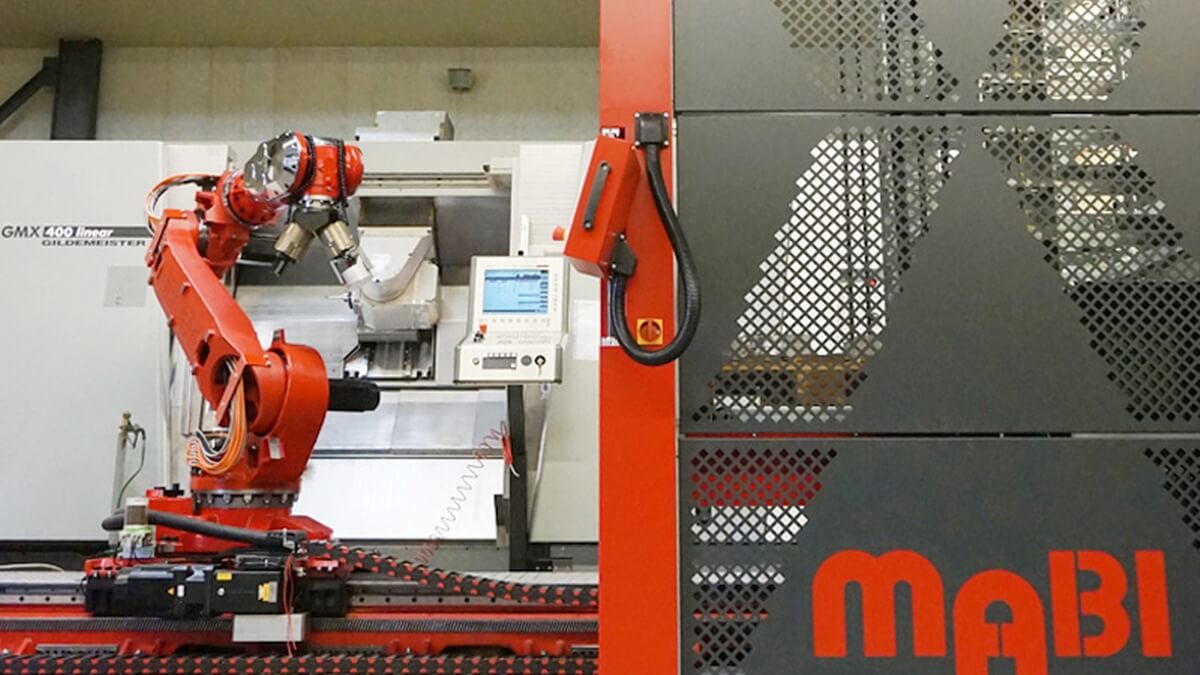MABI Robotic proudly presents its highly specialized portfolio of milling robots, linear axes and rotary tilt tables equipped with secondary encoders on all axes.
This pioneering technology gives MABI Robotic's industrial robots unrivaled accuracy and increased rigidity, making them ideal companions for additive and subtractive CNC applications.
At the center of our product range are the MAX robots, which are offered in various sizes and are continuously being further developed. The MAX-100-2.25-P robot arm, currently the smallest version of the MAX series, is the cornerstone for outstanding precision, impressive payload and reach. Our milling robots set standards in terms of performance, so that companies that previously had to work with sub-optimal robots can now benefit from our high-performance products.

Using high-resolution secondary encoders on each axis, MABI Robotic's 6-axis industrial robots achieve unprecedented precision and rigidity. The system, which measures directly on the axes, corrects even the smallest deviations and enables path accuracy in the micrometer range. As a result, a MABI robot arm combines the flexibility of a robot with the precision of a machine tool, making it the ideal companion for subtractive CNC processes such as milling or grinding as well as for additive manufacturing.
In addition, our robot arms can be extended with linear axes and rotary swivel tables to increase the working space and process workpieces with high precision from optimal angles. Particularly when processing with dynamic forces and rapid movements, the need for subsequent corrections is reduced to a minimum, which saves time and money and relieves operating personnel.
The consistently high accuracy that has become standard at MABI Robotic has allowed us to appeal to numerous companies looking for more precise solutions.
The continuous expansion and improvement of our product range is based on the valuable feedback and specific requirements of our customers. This allows us to cover a wider range of applications and always offer you the most suitable product for your individual project.
You can already look forward to our next innovation in the field of milling robots. The MAX-200-2.5-P robotic arm, which is already in development and production, will usher in a new era of precise heavy-duty robots. From the fourth quarter of 2024, this impressive model will be available to meet even the most demanding requirements in industrial manufacturing. We will be happy to meet you in person at our company or over the phone to provide you with comprehensive advice and explain the benefits of our high-precision milling robots and robotic arms.

All robots in the MAX series are characterized by enormous stiffness and accuracy under load — for example, the MAX-100 achieves stiffness equivalent to three times its own payload.
With this performance, our milling robots are setting new standards and enabling companies that have previously worked with less precise or less powerful robots to significantly increase their productivity. In addition, the MAX robots are completely CNC-controlled: The integration of the Siemens SINUMERIK One controller allows familiar programming using G-code and uses proven technology cycles from the world of machine tools.
At the heart of our product range are the 6-axis MAX robotic arms, which are available in several versions ranging from 100 kg to 200 kg payload and are constantly being further developed. The compact model MAX-100-2.25-P offers 100 kg load capacity with a range of 2.25 m and thus sets new standards in precision and performance for compact industrial robots. In addition, powerful variants for larger loads are available with the MAX-150-2.0-P (150 kg payload, 2.0 m range) and the MAX-200-2.5-P (200 kg payload, 2.5 m range).

The consistently high accuracy of our robotic systems has meant that more and more companies with special requirements rely on MABI Robotic to find more precise solutions. In close dialogue with our customers, we are continuously expanding and improving our product range. Valuable feedback and specific practical requirements flow directly into development. As a result, we are able to cover an ever wider range of applications and offer every customer the most suitable system for their project.
This consistent development makes our milling robots extremely versatile tools. MABI robot arms are successfully used today in many industries — from aerospace and the automotive industry to model and mold making. They process a wide variety of materials such as wood, aluminum, steel or carbon-fiber-reinforced plastics with the highest precision. Thanks to their performance, they are also suitable for demanding additive manufacturing processes. For example, a MABI robot arm can switch between a laser deposition welding head and a milling spindle in order to first additively construct a metal component in a hybrid process and then process it subtractively. In this way, our robots replace several conventional machines in some cases and open up completely new manufacturing strategies.

With the MAX-200-2.5-P, MABI Robotic has ushered in a new era of precise heavy-duty robots. With a load capacity of 200 kg and a range of 2.5 m, this model sets new standards for heavy processing tasks without sacrificing accuracy.
The robotic arm is already being used successfully in industrial production and meets even the most demanding requirements. This allows even very large workpieces or massive components to be machined precisely and automatically. We would be happy to provide you with a personal consultation to show you the benefits of our high-precision milling robots and robotic arms for your application.
The MABI robot arm was developed for milling processes and should therefore have a high level of accuracy. Milling robots from other manufacturers are often converted standard products, which is why they lag behind in terms of accuracy and rigidity. The milling robots from the MAX series are designed to absorb the process forces of milling operations. When compared with similar robots, the differences lie primarily in the high-precision kinematics, the increased rigidity, the use of secondary encoders and the CNC control. Another difference lies in the factory calibration with a measurement protocol specially developed for the milling robots. The system can also be supplied "ready to run".
Our robot arms have been developed for precise machining processes. Materials that are processed by MABI robots are wood, aluminum, steel and CFRP. We can test other materials you require. Due to its precision, the milling robot can of course also be used in other areas. A large area of application is in additive manufacturing. For example, the robot arm can be used to switch between a laser deposition welding head and a milling spindle. This means that work processes can be carried out with one robot arm instead of two machines. At the moment, many of our milling robots are used in companies that have to machine large components, such as in the aviation or automotive industries. Perhaps you have a new area of application for our milling robots. We will be happy to support you in clarifying your application.
Standard robotic systems usually use a single encoder mounted on the motor. The encoder provides speed and position feedback to the controller. This gives us precise position information from the drive side. Due to the backlash of the gears, there is a small deviation on the output side, which increases with each additional axis. To increase the accuracy of the milling robots, the output side is measured with a second encoder. This allows the difference caused by backlash etc. to be readjusted. A secondary encoder and high-precision kinematics are therefore required for an accurate robot arm.
Programming is carried out using NX CAD and CAM software from Siemens. As with CNC machines, the program is created in CAM and then converted into G-code using a post-processor. Alternatively, conventional programming is also possible for simple applications — the SINUMERIK controller offers a variety of standardized cycles that can be used flexibly.
The open Siemens architecture also enables close integration between CAD, CAM and control, which allows complex milling processes to be efficiently mapped. Since the milling robot arm is integrated into the Siemens ecosystem, users benefit from consistent workflows, reduced set-up costs and a high level of process reliability. The robot arm can be fully programmed with G-code, which allows CNC-experienced integrators a seamless introduction to robot-based milling processing.
Each robot arm is measured and calibrated before delivery. To do this, we use a high-precision Leica laser tracker, which precisely detects the robot in various positions.
By means of this measurement method, the kinematic structure of the robot arm is determined with high precision. The parameters determined flow directly into the controller and ensure that the milling robot achieves a high level of repeatability right from the factory. The system is calibrated not only in a static state but also under real movement conditions — a decisive advantage for demanding milling applications with tight tolerances.
Factory calibration includes measuring selected DH parameters and adjusting the kinematically ideal zero position of the axes. The optional ISIOS system supplements this basic calibration with additional functions such as model-based active compensation, dynamic gravity correction and precise recalibration options in the operational environment.
ISIOS offers advantages, particularly for complex milling processes: Plant-based model measurement not only increases accuracy, but also improves their stability over longer operating cycles. ISIOS represents an important extension for users who use the milling robot arm in particularly precise or temperature-critical environments.
Our robotic arm has been specially optimized for milling processes and, with its structural stiffness and repeatability, achieves values that are close to modern portal milling machines. At the same time, it remains flexible to use — our milling robot is an economically attractive alternative, especially for large components.
However, the achievable component accuracy depends largely on the complexity of the processing process, the spindle used, the milling tool and the material properties. In certain cases, classic CNC centers can still be an advantage when it comes to extreme precision requirements. Our milling robot arms, on the other hand, offer an ideal balance between precision, flexibility and investment costs — especially for large-volume or geometrically complex parts.

The selection of a suitable spindle depends largely on the specific application. Both the weight of the spindle and its performance characteristics are decisive. In order to be able to better absorb the dynamic forces during the milling process, we recommend — where technically possible — the use of a spindle that is as lightweight as possible.
It is important that the spindle characteristic (torque, power and speed range) is tailored to the material to be processed and the process. For highly dynamic processing, such as processing plastics or aluminum, spindles with high speeds and low weight are generally preferred. Under Accessories, you will find a selection of spindles that are offered as standard. On request, we can also check the integration of specific spindle models for your application — especially if your milling robot arm is to be used in highly specialized processes.
Yes, we offer feasibility studies to evaluate individual applications. Specially equipped robot cells with the MAX100 and MAX200 models are available for this purpose, in which tests are carried out under real conditions.
Our studies include both geometric and procedural analyses, for example with regard to tool path strategy, processing times and achievable tolerances. After carrying out the tests, we create detailed documentation and discuss the results with you. On request, we can develop a tailor-made test concept that is precisely tailored to your requirements. For companies that want to integrate the milling robot arm into new or non-standardized areas of application, a feasibility study is a valuable planning step.
We deliver our milling robots as completely preconfigured ready-to-run systems. You get the robot arm including control cabinet, milling spindle and SINUMERIK ONE controller — fully coordinated with the associated Siemens software.
Start-up only requires the connection of the prepared components. All system parameters are preconfigured so that no time-consuming basic programming is necessary. The documentation provided and our technical support make initial start-up even easier. For more extensive projects, we recommend working closely with one of our integration partners in order to efficiently utilize the full potential of the milling robot — even for complex automation.